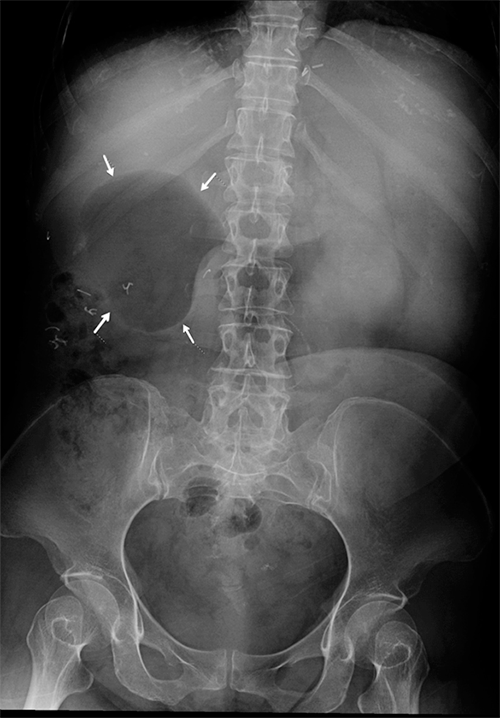Discussion
Down syndrome is associated with various gastrointestinal anomalies, including duodenal atresia (6%),1 annular pancreas, gastrointestinal reflux, imperforate anus, and Hirschsprung disease. Additionally, malrotation, Meckel’s diverticulum, and duodenal web appear more common in this population.2‒5 Congenital cardiac defects are also well described in these patients. They may be a potential source of surgical morbidity.6 Current operative management of duodenal atresia consists of duodenoduodenostomy or duodenojejunostomy.7 Perhaps at the time of initial presentation and exploration as an infant in our patient, it may not have been precisely clear where the bile and pancreatic ducts entered the atretic duodenum and so gastrojejunostomy may have been chosen instead.
Jejunogastric intussusception following gastrojejunostomy is exceedingly rare, with approximately 300 cases reported in the literature. This finding arises as a complication of prior surgical anastomosis. Most reported cases (74%) involve the efferent limb of the gastrojejunostomy, but afferent and combined limb intussusception have been described.8‒10 The mechanism is likely related to retrograde peristalsis. Still, long afferent limb, jejunal spasm, abnormal motility, hyperacidity, and increased intraabdominal pressure have also been implicated.11,12 There were no lead points for this condition described in the literature, so resection based solely on concern for anatomic causes appears unnecessary.
Endoscopic reduction has been described, but the risk of perforation or recurrence is high.13,14 Potential surgical options for intussusception depend largely upon intraoperative findings and intestinal viability. They include simple reduction with or without fixation and revision or resection with re anastomosis.8 Another potential option is to convert the gastrojejunostomy to Roux-en-Y configuration, mainly if nonviable intestine is encountered at exploration. In our case, the afferent limb was short in length because the index gastrojejunostomy had been constructed close to the duodenum, completely to the right of the midline. The limb was also partially tethered in the retroperitoneum from prior surgery. If a long afferent limb had been encountered, additional pexy of the afferent to the efferent limb, similar to a Braun jejujo-jejunostomy but without anastomosis, could have also been considered.
Conclusion
We report a case of gastrojejunal intussusception, an exceedingly rare complication of gastrojejunostomy with a good outcome. Optimal surgical management is dependent upon operative findings and bowel viability.
Lessons Learned
Careful analysis of preoperative imaging is especially useful when no prior surgical historical details are available. Endoscopy can be useful, especially when gastrojejunal intussusception is suggested by radiologic workup in a stable patient. The lack of a lead point in all reported cases makes resection unnecessary unless bowel viability is in question.
Acknowledgments
Dr. Martínez-Zavala and Mariana Tapia Vazquez contributed to the illustration.
References
- Stoll C, Alembik Y, Dott B, Roth MP. Study of Down syndrome in 238,942 consecutive births. Ann Genet. 1998;41(1):44-51.
- Eksarko P, Nazir S, Kessler E, et al. Duodenal web associated with malrotation and review of literature. J Surg Case Rep. 2013;2013(12):rjt110. Published 2013 Dec 18. doi:10.1093/jscr/rjt110
- Mirza B, Sheikh A. Multiple associated anomalies in patients of duodenal atresia: a case series. J Neonatal Surg. 2012;1(2):23. Published 2012 Apr 1.
- Frid C, Drott P, Lundell B, Rasmussen F, Annerén G. Mortality in Down's syndrome in relation to congenital malformations. J Intellect Disabil Res. 1999;43 ( Pt 3):234-241. doi:10.1046/j.1365-2788.1999.00198.x
- Buchin PJ, Levy JS, Schullinger JN. Down's syndrome and the gastrointestinal tract. J Clin Gastroenterol. 1986;8(2):111-114. doi:10.1097/00004836-198604000-00002
- Angotti R, Molinaro F, Sica M, et al. Association of Duodenal Atresia, Malrotation, and Atrial Septal Defect in a Down-Syndrome Patient. APSP J Case Rep. 2016;7(2):16. Published 2016 Apr 24.
- Fonkalsrud EW, DeLorimier AA, Hays DM. Congenital atresia and stenosis of the duodenum. A review compiled from the members of the Surgical Section of the American Academy of Pediatrics. Pediatrics. 1969;43(1):79-83.
- Irons HS Jr, Lipin RJ. Jejuno-gastric intussusception following gastro-enterostomy and vagotomy. Ann Surg. 1955;141(4):541-546. doi:10.1097/00000658-195504000-00017
- Rather SA, Dar TI, Wani RA, Khan A. Jejunogastric intussusception presenting as tumor bleed. J Emerg Trauma Shock. 2010;3(4):406-408. doi:10.4103/0974-2700.70775
- Czerniak A, Bass A, Bat L, Shemesh E, Avigad I, Wolfstein I. Jejunogastric intussusception. A new diagnostic test. Arch Surg. 1987;122(10):1190-1192. doi:10.1001/archsurg.1987.01400220100019
- Waits JO, Beart RW Jr, Charboneau JW. Jejunogastric intussusception. Arch Surg. 1980;115(12):1449-1452. doi:10.1001/archsurg.1980.01380120023006
- Archimandritis AJ, Hatzopoulos N, Hatzinikolaou P, et al. Jejunogastric intussusception presented with hematemesis: a case presentation and review of the literature. BMC Gastroenterol. 2001;1:1. doi:10.1186/1471-230x-1-1
- Kochhar R, Saxena R, Nagi B, Gupta NM, Mehta SK. Endoscopic management of retrograde jejunogastric intussusception. Gastrointest Endosc. 1988;34(1):56-57. doi:10.1016/s0016-5107(88)71233-x
- Toth E, Arvidsson S, Thorlacius H. Endoscopic reduction of a jejunogastric intussusception. Endoscopy. 2011;43 Suppl 2 UCTN:E63. doi:10.1055/s-0030-1256103
Authors
Martínez-Zavala VEa; Cataneo-Serrato Ja; Dwijendra STb, Major SMb; Hyser MJc
Author Affiliations
- University of Illinois College of Medicine at Chicago (Metropolitan Group), Chicago, IL 60657
- Department of Diagnostic Radiology, AMITA Health Saint Francis Hospital, Evanston, IL 60202
- Department of Surgery, AMITA Health Saint Francis Hospital, Evanston, IL 60202
Corresponding Author
Victor E. Martínez-Zavala, MD
Advocate Illinois Masonic Medical Center
836 W. Wellington Avenue, Ste. 4800
Chicago, IL 60657
Phone: 913-601-1972
Email: vemz.1989@gmail.com
Disclosure Statement
The authors have no conflicts of interest to disclose.
Funding/Support
The authors have no relevant financial relationships or in-kind support to disclose.
Received: September 8, 2020
Revision received: November 8, 2020
Accepted: November 24, 2020






